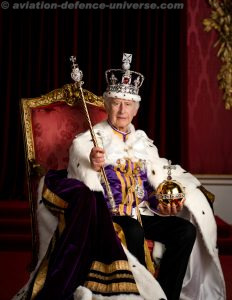- Andrew Jamieson was commissioned to create the coronation invitation, which featured the couple’s coats of arms, the floral emblems of the United Kingdom, and a Green Man amid other British wildflowers and wildlife. The coronation emblem was designed by Jony Ive with his creative collective LoveFrom, and depicts the floral emblems of the United Kingdom in the shape of St Edward’s Crown. There are versions of the emblem in both English and Welsh.
- The procession into the abbey was led by the Cross of Wales, a new processional cross commissioned by Charles to mark the centenary of the Church in Wales. It includes relics of the True Cross gifted to the King by Pope Francis. The screen which concealed the King during his anointing was designed by iconographer Aidan Hart and embroidered by the Royal School of Needlework. It includes 56 leaves embroidered with the names of the members of the Commonwealth of Nations.
- The Poet Laureate of the United Kingdom, Simon Armitage, released a new poem, An Unexpected Guest, to mark the coronation. The poem follows a woman invited to attend the coronation in Westminster Abbey, and quotes Samuel Pepys’ experience at the coronation of Charles II in 1661.
- The official photographer of the coronation was Hugo Burnand, who had previously been the official photographer for Charles and Camilla’s wedding in 2005. Eileen Hogan was selected to paint the coronation ceremony, and Peter Kuhfeld and Paul Benney to paint the coronation portraits of Charles and Camilla respectively. Three alumni of The Royal Drawing School, Fraser Scarfe, Phoebe Stannard and Gideon Summerfield, were picked to document the procession.
- The dress code for peers without a role in the ceremony was originally business suits or parliamentary robes, rather than the coronets, coronation robes, and court dress traditionally worn. This was changed in the week before the coronation after protests, with peers allowed to wear coronation robes but not coronets. The general dress code for men was morning dress, a lounge suit or national dress
- The organisation of the coronation was the responsibility of the earl marshal, Edward Fitzalan-Howard. A committee of privy counsellors arranged the event. On 11 October 2022, the date of the coronation was announced as 6 May 2023, a choice made to ensure sufficient time to mourn the death of Queen Elizabeth II before holding the ceremony.
- Westminster Abbey was closed to tourists and worshippers from 25 April for preparations, and would not re-open until 8 May. As at previous coronations, many attendees had an obscured view, as the abbey’s nave was filled to capacity.
- The holy anointing oil used in the service was consecrated at the Church of the Holy Sepulchre on 6 March 2023 by Patriarch Theophilos III of Jerusalem, under the supervision of Hosam Naoum, the Anglican archbishop of Jerusalem. It was based on the same formula as the oil used in the coronation of Elizabeth II, but without animal products such as civet.
- Military dress rehearsals took place on 17, 18, and 19 April. On 3 May, Charles and Camilla, William, Prince of Wales, Catherine, Princess of Wales, their children, and Anne, Princess Royal, attended coronation rehearsals at Westminster Abbey.
- St Edward’s Crown, which was used to crown the King, was removed from the Tower of London in December 2022 for resizing. In February 2023 Queen Mary’s Crown, which was used to crown Camilla, was also removed from display to be reset with Cullinan III, IV and V and for four of its eight detachable arches to be removed. The Crown of Queen Elizabeth The Queen Mother was not used, to avoid a potential diplomatic dispute with India; the crown contains the Koh-i-Noor diamond, which is claimed by the former colony.























































































































